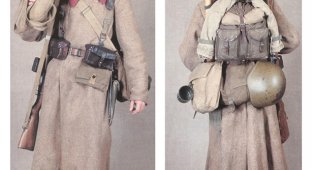About buttons (31 photos)
Buttons have a rich history; the first fasteners resembling buttons appeared around the 3rd millennium BC. During excavations in the Indus Valley, a real button with two holes for sewing was found.

Buttons are also occasionally found in ancient excavations, sometimes very beautiful: made of terracotta, gilded, etc.
Already in the IV-III millennium BC. our ancestors living in the territory of the modern Moscow region wore amber buttons in the form of a disk with two holes.

so-called prehistoric buttons
In pre-Petrine Russia, buttons on clothes were a kind of “calling card” of the owner. Their number, shape, patterns and signs on them could tell about a person’s position, his merits, and proximity to power. Each type of dress was assigned a strictly defined number of buttons: 3, 8, 10, 11, 12, 13 or 19 buttons were sewn onto a caftan; for a fur coat - 8, 11, 13, 14, 15, 16, etc. The largest number of buttons was supposed to be on the tigilaeum. On the tigils of Ivan IV, for example, there were: on one - 48, on the other - 68 gold buttons. The presence of decorations on the buttons themselves (in the form of tassels) is also characteristic.

Top of the fur coat. Presumably belonged to Tsar Alexei Mikhailovich.
During the early Middle Ages, buttons were used little; the dress was held together mainly by lacing and hooks. Costume reform in the 13th century. - the invention of cut, which made it possible to wear tight-fitting clothes, like a second skin, led to the massive use of buttons. In Paris, unions of artisans emerged - workshops that united button makers who worked with a certain material: metal, bone, glass. Button production soon became a significant part of the European economy. They were made from gold, silver, coral, amber, and pearls.

Silver buttons. Austria. Around the 17th century
In the chronicle of the 15th century. mention is made of four tunics given to the widow of a nobleman who was executed by the Duke of Milan. Each tunic had from 40 to 126 gold buttons. In general, the number of buttons far exceeded practical needs. For example, in 1757 The English Duke of Bedford paid five pounds (the monthly income of a wealthy artisan) for a uniform with a hundred buttons.
The extent to which buttons were used and the importance attached to them is demonstrated by the fact that their production was regulated by the state. When in the 17th century. Buttons covered with fabric and decorated with lace and embroidery came into fashion; French laws required that they be covered exclusively with silk in order to support silk production in Paris and Lyon. In England, at the end of the 17th and beginning of the 18th centuries, covered buttons, on the contrary, were officially prohibited: British button makers were supposed to contribute to the development of metallurgy.
The 18th century is called the golden age of buttons, when their variety was limitless. The following materials were used for production: gold, silver, tin, steel, brass, glass, horn, ivory, mother-of-pearl, tortoiseshell, enamel, wood.

Buttons with watercolor inserts. France. Late 18th or early 19th century.

France. End of the 18th century
Favorite motifs were romantic landscapes, architecture, mythological characters, cupids and shepherdesses. After the French Revolution, political subjects also appeared on buttons, and the buttons issued in honor of the inauguration of George Washington in 1789 and 1793 are still considered one of the most valuable in the world. Sets of buttons from 5 to 35 pieces were often made on a specific theme: travel, scenes of colonial life, etc. As a rule, such sets were made to order and sold in boxes covered with silk.
The best artists and inventors of their time worked in the “button field”. For example, a set of buttons for Louis XIV was painted by the famous painter Antoine Watteau.
In 1767, Matthew Boulton invented the "diamond" cut of steel, which resulted in a small piece of steel having the appearance of a diamond. Sometimes there were more than 150 of these “diamonds” on one button. You can imagine how difficult the work was if each grain was separately riveted to the base of the button.

Mother of pearl buttons. Presumably France. XVIII century
Mikhail Vasilyevich Lomonosov also made his contribution to the “button business”: in 1753 he founded a factory for the production of glass and mosaics, which also produced glass buttons. They say that at one high-society reception Lomonosov appeared in clothes decorated with glass buttons, for which he was ridiculed by the President of the Academy of Arts I.I. Shuvalov: why are you, Mikhailo Vasilyevich, unable to afford normal buttons made of silver or gold with gems? Lomonosov's response to the offender was the poetic “Letter on the Benefits of Glass.”
England continued to lead in the production of metal buttons. A variety of technologies were used: stamping, casting, turning, engraving and many others. King George III himself began developing new models of buttons, for which he was ridiculed in the pamphlet “Anecdotes about the Button Maker.”

Copper buttons. Presumably England. XVIII century

Buttons with the image of insects, covered with glass. Mid or late 18th century.
Buttons became more accessible to the general population at the end of the 18th – beginning of the 19th centuries, when large factories appeared. Production secrets were strictly guarded; English button makers were even forbidden to emigrate, so that the technology would not get abroad. In 1807, the Dane Bertel Sanders invented a button consisting of two separate discs. Lightweight, linen-coated underwear buttons immediately appeared. In the 19th century, cow hoof and wood from the corozo plant became the most popular materials. In the 19th century More and more new technologies are being used in the button business. Covered buttons are now produced using machines, porcelain buttons are painted using a stencil, and a much-needed product is pressed from heat-softened animal horns and hooves. In the middle of the century, after the discovery of the rubber vulcanization process, Nelson Gullier in America began producing hard rubber buttons.


France, 1815-1816
It is interesting that until the 19th century. the button remained the privilege of men. Only a third of all buttons were used for women's clothing. And only by the middle of the century, along with Haute Couture, the realization came to France that a button in a woman’s dress could be not only functional, but also decorative.
Queen Victoria gave an unexpected impetus to the development of buttons. In 1861, Prince Albert, the queen's husband, died. The trap lasted 25 years, and black dominated the fashion of that time. The Queen issued a special decree on the order of funeral procedures. It, in particular, spoke of the need to use opaque black buttons in widows' mourning dresses. In the queen's own mourning, natural agate played this role, but for millions of widows, strict black buttons made of glass or trimmed with black fabric were needed. It was in the production of this type of button that the factory in Gablons (Bohemia) began to specialize, finding such an unexpected use for its glass products.

Silver English and French buttons in Art Nouveau style. 1900-1910
A true revolution in the history of industrial production of buttons was the use of plastics, which replaced all other materials in less than a century. The “progenitors” of the plastic button were the so-called gallinite buttons, which were made from compacted casein, a milk coagulant that was produced in dairy plants in Argentina, dried and delivered to France. After appropriate processing, it took the form of agate, the true origin of which the average person had no idea about. The first was celluloid, invented in the 60s. XIX century; it was easy to machine and could be painted in any color. Not only simple linen buttons were made from it, but also exquisitely beautiful ones intended for ballroom dresses.

Celluloid buttons. Beginning of the 20th century
In the 20s XX century The most common buttons were made of Bakelite plastic, called “the material of a thousand possibilities.” At the same time, figured buttons came into fashion - in the form of animals, plants, wax, etc. Parisian Elsa Schiaparelli, trendsetter of women's fashion in Paris in the 1930s. In collaboration with a certain Jean Clement, who graduated from art school and was at the same time well educated in the field of chemistry, they were passionate about surrealism. Together, they produced a huge number of previously unseen buttons of various shapes and colors, including phosphorescent ones. There were buttons in the shape of fruits - lemons, oranges, grapefruits, ballerina figures, spoons, Christmas bells, horses, shoelaces, paper clips. Buttons are small transparent boxes filled with grains of rice and coffee, or rows of decreasing butterflies. All of these pieces had a surrealistic feel and were intended for any part of the costume where there was room for them - even on hats. The Madame Schiap salon opened by Elsa on Place Vendôme was a huge success.
After the Second World War, there was a catastrophic shortage of raw materials for the production of buttons, so any material at hand was used: in Germany, buttons were produced from the windshield of decommissioned fighter planes, and an artel near Moscow stamped them from gramophone records softened in a fire. In the 50-60s. XX century Stained glass buttons, produced in West Germany and Czechoslovakia, became popular all over the world. Pure bright colors, gold and silver trim, and thoughtful design made them a wonderful addition and decoration to women's clothing. Despite the fact that the production process is labor-intensive, with a predominance of manual operations, glass buttons successfully competed with plastic ones until the early 80s. And only with the widespread use of household washing machines, which spoil and break fragile glass, they had to be abandoned.

Plastic buttons. USA. 30s XX century
Here's what you can make from ordinary buttons with a little imagination.







































